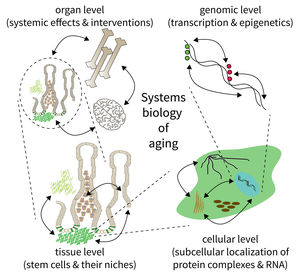Subarea 5: Computational and Systems Biology of Aging
Subarea 5 focuses on the development of methods to analyse and understand complex biological systems. This work includes the design of computer algorithms and biostatistical approaches as well as the development of novel Omic strategies (i.e. genomics/epigenomics, transcriptomics, proteomics, and metabolomics) to study aging and aging-related diseases. According to the FLI, due to the Subarea's expertise in computational data analysis, it is deeply interconnected with all other Subareas. The Subarea hosts two critical core facilities (Life Science Computing, Proteomics) and provides consulting services in statistics. Furthermore, it organizes courses on data analysis and statistics.
The research is defined by five focus areas:
- Mapping extrinsic and intrinsic factors influencing stem cells during aging,
- Integration of spatiotemporal proteomics and transcriptomics data,
- Comprehensive evaluation of qualitative and quantitative expression changes,
- Identification and analysis of epigenomic alterations during aging and age-related diseases, and
- Network analysis of genomic, transcriptomic and epigenomic alterations during aging.
Research focus of Subarea 5.
The biology of aging can be viewed as a multilayered array of networks at the level of organs, cells, molecules, and genes. The FLI wants to meet this complexity by establishing the new Subarea on “Computational and Systems Biology of Aging”. The overall goal is to interconnect research at different scales, taking place in Subareas 1-4 of the Institute’s research program. The new group on Systems Biology will integrate data from networks at multiple scales and will thus point to mechanisms and interactions that would not be seen in unilayer approaches.
Publications
(since 2016)
2018
- Higher gene expression stability during aging in long-lived giant mole-rats than in short-lived rats.
Sahm A, Bens M, Henning Y, Vole C, Groth M, Schwab M, Hoffmann S, Platzer* M, Szafranski* K, Dammann* P
Aging (Albany NY) 2018, 10(12), 3938-56 * equal contribution - Long-lived rodents reveal signatures of positive selection in genes associated with lifespan.
Sahm A, Bens M, Szafranski K, Holtze S, Groth M, Görlach M, Calkhoven C, Müller C, Schwab M, Kraus J, Kestler HA, Cellerino A, Burda H, Hildebrandt T, Dammann P, Platzer M
PLoS Genet 2018, 14(3), e1007272 - A Boolean network of the crosstalk between IGF and Wnt signaling in aging satellite cells.
Siegle* L, Schwab* JD, Kühlwein* SD, Lausser L, Tümpel S, Pfister AS, Kühl** M, Kestler** HA
PLoS One 2018, 13(3), e0195126 * equal contribution, ** co-senior authors - NUFIP1 is a ribosome receptor for starvation-induced ribophagy.
Wyant* GA, Abu-Remaileh* M, Frenkel EM, Laqtom NN, Dharamdasani V, Lewis CA, Chan SH, Heinze I, Ori** A, Sabatini** DM
Science 2018, 360(6390), 751-8 * equal contribution, ** co-corresponding authors
2017
- Tissue-, sex- and age-specific DNA methylation of rat glucocorticoid receptor gene promoter and insulin like growth factor 2 imprinting control region.
Agba OB, Lausser L, Huse K, Bergmeier C, Jahn N, Groth M, Bens M, Sahm A, Gall M, Witte OW, Kestler HA, Schwab M, Platzer M
Physiol Genomics 2017, 49(11), 690-702 APSselect for distinction in scholarship in the Physiological Genomics - What have we learned on aging from omics studies?
Cellerino A, Ori A
Semin Cell Dev Biol 2017, 70, 177-89 - Architecture of the yeast Elongator complex.
Dauden MI, Kosinski J, Kolaj-Robin O, Desfosses A, Ori A, Faux C, Hoffmann NA, Onuma OF, Breunig KD, Beck M, Sachse C, Séraphin B, Glatt S, Müller CW
EMBO Rep 2017, 18(2), 264-79 - Proteomic Analysis Reveals GMP Synthetase as p53 Repression Target in Liver Cancer.
Holzer K, Drucker E, Roessler S, Dauch D, Heinzmann F, Waldburger N, Eiteneuer EM, Herpel E, Breuhahn K, Zender L, Schirmacher P, Ori A, Singer S
Am J Pathol 2017, 187(2), 228-35 - Semantic biomarker selection for functional genomics of heart failure model organisms
Lausser L, Just S, Rottbauer W, Kestler HA
In: 2017 Computing in Cardiology (CinC), Rennes,France 2017 2017, 1-4, IEEE Publications, Los Alam - Generalized enhanced suffix array construction in external memory.
Louza FA, Telles GP, Hoffmann S, Ciferri CDA
Algorithms Mol Biol 2017, 12, 26









